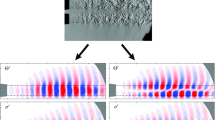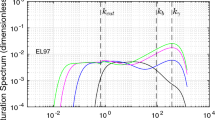Abstract
Statistical characteristics of individual waves in laboratory wind waves have been studied by use of a wind-wave tunnel. The individual waves are defined by actual undulations of the water surface at any instant, and are characterized by concentrated shearing stress and strong vorticity at their crests. A conspicuous self-similarity structure is found in the individual wave field. The similarity manifests itself as a simple spectral form, and as the statistical 3/2-power law between nondimensional wave height and wave period, and further as the -1/2-power relationship between nondimensional phase speed and frequency, for waves of the high frequency side. The normalized energy spectrum, specially defined for individual waves, has a form practically equivalent to the traditional spectrum for component waves in the main frequency range from 0.7 to 1.5 in the frequency normalized by the peak frequency, but does not have secondary peaks at harmonics. The phase speed of individual waves also coincides with that of component waves in the main frequency range.
Similar content being viewed by others
References
Banner, M. L. andO. M. Phillips (1974): On the incipient breaking of small scale waves. J. Fluid Mech.,65, 647–656.
Banner, M. L. andW. K. Melville (1976): On the separation of air flow over water waves. J. Fluid Mech.,77, 825–842.
Chang, P. C., E. J. Plate andG. M. Hidy (1971): Turbulent air flow over the dominant component of wind-generated water waves. J. Fluid Mech.,47, 183–208.
Cox, C. S. (1958): Measurements of slopes of high-frequency wind waves. J. Mar. Res.16, 199–225.
Hidy, G. M. andE. J. Plate (1965): Wind action on water standing in a laboratory channel. J. Fluid Mech.,26, 651–687.
Kato, H. andK. Tsuruya (1974): On the phase velocity of component waves of wind waves (in Japanese). Proc. 21st Japanese Conf. Coast. Eng., 255–259.
Kawai, S. (1981): Visualization of air-flow separation over wind-wave crests under moderate wind. Boundary-Layer Meteorol.,21, 93–104.
Kawai, S., K. Okada andY. Toba (1977): Support of the three-seconds power law and thegu*σ−4-spectral form for growing wind waves with field observational data. J. Oceanogr. Soc. Japan,33, 137–150.
Kuo, Y.Y., H. Mitsuyasu andA. Masuda (1979): Experimental study on the phase velocity of wind waves. Part 1. Laboratory wind waves. Rep. Res. Inst. Appl. Mech., Kyushu Univ.,27, 1–19.
Lake, B., H. Yuen, H. Rungaldier andW. Ferguson (1977): Nonlinear deep-water waves: theory and experiment. Part 2. Evolution of a continuous wave train. J. Fluid Mech.,83, 49–74.
Lake, B. andH. Yuen (1978): A new model for nonlinear wind waves. Part 1. Physical model and experimental evidence. J. Fluid Mech.,88, 33–62.
Masuda, A., Kuo, Y. Y. andH. Mitsuyasu (1979): On the dispersion relation of random gravity waves. Part 1. Theoretical framework. J. Fluid Mech.,92, 717–730.
Mitsuyasu, H., Y. Y. Kuo andA. Masuda (1979): On the dispersion relation of random gravity waves. Part 2. An experiment. J. Fluid Mech.,92, 731–749.
Mollo-christensen andA. Ramamonjiarisoa (1978): Modelling the presence of wave groups in a random wave field. J. Geoph. Res.,83, 4117–4122.
Neumann, G. (1952): On wind generated ocean waves with special reference to the problem of wave forecasting. Dept. Met. and Oceanogr., New York Univ. Prepared for Office of Naval Res., 136 pp.
Okuda, K. (MS): Internal flow structure of short wind waves. Parts I, II and III. Submitted to J. Oceanogr. Soc. Japan.
Okuda, K., S. Kawai, M. Tokuda andY. Toba (1976): Detailed observation of the wind-exerted surface flow by use of flow visualization method. J. Oceanogr. Soc. Japan,32, 51–62.
Okuda, K., S. Kawai andY. Toba (1977): Measurement of skin friction distribution along the surface of wind waves. J. Oceanogr. Soc. Japan,33, 190–198.
Phillips, O. M. (1958): The equilibrium range in the spectrum of wind-generated waves. J. Fluid Mech.,4, 426–434.
Phillips, O. M. andM. L. Banner (1974): Wave breaking in the presence of wind drift and swell. J. Fluid Mech.,66, 625–640.
Pierson, W. J., Jr. (1952): A unified mathematical theory for the analysis, propagation and refraction of strom generated ocean surface waves. Parts I and II. Dept. Met. and Oceanogr., New York Univ. Prepared for Beach Erosion Board and Office of Naval Res., 461 pp.
Ramamonjiarisoa, A. (1974): Contribution à l'étude de la structure statistique et des mécanismes de génération des vagues de vent. Thèse à L'Université de Provence (Inst. Méch. Stat. de la Turbulence, No. A.O. 10023), 160 pp.
Rikiishi, K. (1978): A new method for measuring the directional wave spectrum. Part II. Measurement of the directional spectrum and phase velocity of laboratory wind waves. J. Phys. Oceanogr.,8, 519–529.
Sverdrup, H. U. andW. H. Munk (1947): Wind, sea and swell: Theory of relations for forecasting. U.S. Navy Hydrogr. Office, Wash., Pub. No. 601, 44 pp.
Toba, Y. (1972): Local balance in the air-sea boundary processes. I. On the growth process of wind waves. J. Oceanogr. Soc. Japan,28, 108–120.
Toba, Y. (1973): Local balance in the air-sea boundary processes. III. On the spectrum of wind waves. J. Oceanogr. Soc. Japan,29, 209–220.
Toba, Y. (1978): Stochastic form of the growth of wind waves in a single parameter representation with physical implications. J. Phys. Oceanogr.,8, 494–507.
Toba, Y. (1979): Study on wind waves as a strongly nonlinear phenomenon. Twelfth Symp. on Naval Hydrodyn., Nat. Acad. of Sci., Wash., D. C., 529–540.
Toba, Y., M. Tokuda, K. Okuda andS. Kawai (1975): Forced convection accompanying wind waves. J. Oceanogr. Soc. Japan,31, 192–198.
Yefimov, V. V., Yu. P. Solov'yev andG.N. Khristoforov (1972): Observational determination of the phase velocities of spectral components of wind waves. Izv., Atmos. Ocean. Phys.,8, 246–251.
Author information
Authors and Affiliations
Rights and permissions
About this article
Cite this article
Tokuda, M., Toba, Y. Statistical characteristics of individual waves in laboratory wind waves I. Individual wave spectra and similarity structure. Journal of the Oceanographical Society of Japan 37, 243–258 (1981). https://doi.org/10.1007/BF02070579
Received:
Revised:
Accepted:
Issue Date:
DOI: https://doi.org/10.1007/BF02070579




